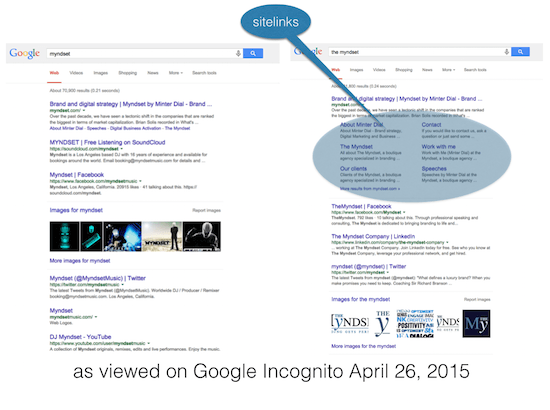Have you ever considered changing the URL domain name of an existing site? In other words, keeping all the content (and structure) the same, you want the root name of the site to be different. At the end of last year, I decided to switch my website domain name from Thewww.minterdial.com to Myndset.com, which I had purchased for not a little amount of money over a year ago. The decision to migrate my URL was not an easy one. Why did I do it?
- Consistency – many of my social handles are @myndset (Facebook, Twitter…)
- It’s shorter, so more convenient for people to type out (and thus better for Twitter)
- To be better referenced on search engines. As different as the name is spelt, I am not the only Myndset! There’s a very happening DJ out in LA called Myndset (see right) that is not only good (I recommend if you like electronic trance music, etc), but very popular… especially on Google
{the} Myndset migration
The story here is specific to a WordPress migration, but surely it has ramifications for other types of site migrations, too. In my case, I was accompanied by a boutique agency. Truth is that no amount of experience will cover all the different situations and permutations that arise from one’s specific case. In any event, having experienced the process, now looking back, here is a closer look at the burning issues of a URL migration.
My context was the following:
- I use a Woo Theme on WordPress (which has a mobile-friendly adaptation)
- At the time of migration, I had just under 1,000 published blog posts and around 12,000 image assets, each with a specific URL
- My Google Page Rank was a 5, Alexa global ranking was around 450,000th and my monthly UVs were around 8,000
Considerations that need to be addressed and questions that ought to be asked before doing it:
- What will be the impact on Google search results?
- What are the consequences in terms of social media?
- How does it impact the readers experience?
- How much time/cost will be necessary? {Please tweet ♺!}
What they might not tell you about URL migration
Aside from meticulously ensuring that every single published URL is given a new destination (via what is called a 301 redirect), there were also the images which are automatically reproduced in multiple formats by the WordPress theme to accommodate the different usages (thumbnails, etc.).
Here’s what I can tell you about what has happened post migration:
- You will lose your Google Page Rank for many months…
- Your Google listing will not be fully fleshed out with sitelinks (see below)
- Your internal links that refer to other posts you have posted will need to be converted
- Having been an avid user of the “Tweet this!” using plug-in tools such as “Easy Embed Tweet,” the post addresses will not be updated to the new URL (so you lose the social numbers)
- Evaluating your traffic versus the past will be a bit more difficult as your history will remain within the old domain name’s listing on Google Analytics
- Far more of an issue: you will lose all your social proof except for lingering Google+ “+1”
In terms of search results, it is clear that, in setting up all your former blog post URLs to redirect to the new URL, Google will penalize each post for the extra step. That is more of an issue for lower ranked and lesser visited pages and posts. For the ones that have higher traffic, it is not as important.
The URL migration journey – key tips
When you finally turn the switch to make the new domain name “live,” you will inevitably encounter other bugs and issues. For example, there may be widgets that have been programmed with the old URL. There will be 404 errors (missing page). Tip #1: I highly recommend getting your inner circle to be aware of the changeover and have them participate in testing your site and helping to identify the bugs. Tip #2: Another important step is to go back into all of your social profiles online to make sure the associated URL is updated. This is important in order to create bona fide linkbacks to your new domain name. Tip #3: keep a separate list of all your social media profiles, complete with URL and username. {♺!} My final tip #4: Use this site migration process as a way to improve site performance. For example, check out load time for the site, strip out unnecessary widgets, optimize images, etc…). {♺!}
Conclusion
Three full months after the migration, my Google Page Rank is at 0, Alexa global ranking is 739,000th and my monthly UVs are at 7,500 (+35% versus last year at the same period). The pain in my side is having lost so much social proof (aka social love). Certain posts had gained several thousand social shares. They have been reduced to zero. Clearly, there is more work to be done. My bottom line is: it will not always make sense for your business to do such a transition. If it is an elective (as in my case), you will need to gauge carefully the pros and cons.{♺!} And, it is certainly preferably to understand what you are getting yourself into ahead of time. Hopefully this post can go some way to clearing up the road ahead if you are planning an URL migration.
For further good reading on the topic:
- MOZ – website migration guide
- Search Engine Journal – Migrating to a new domain
- Search Engine Journal – How to avoid an SEO disaster
Please comment and add your thoughts and lessons learned if you have done something similar!















Sounds awful… I had a big mess up with my website over the last 6 months and now finally got it to work a bit better. Now I need to get a new and reliable host company.
You should tell you story at a Fuck Up night somewhere. I will do that in May.
http://kingscross.impacthub.net/event/fuckup-night-may-2015/
I would love to but not this next one (traveling). Another time?